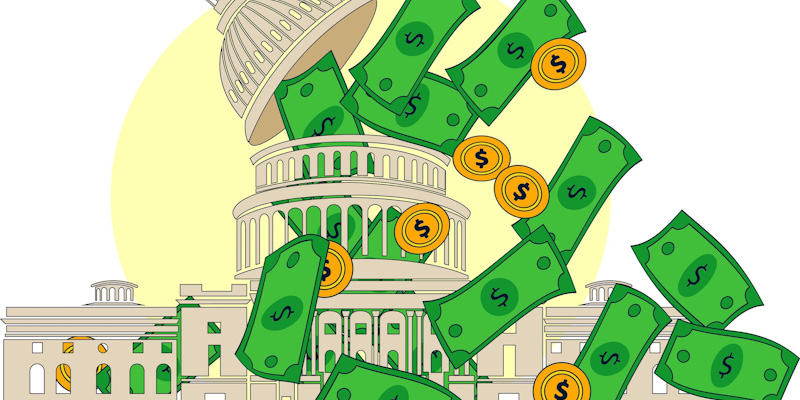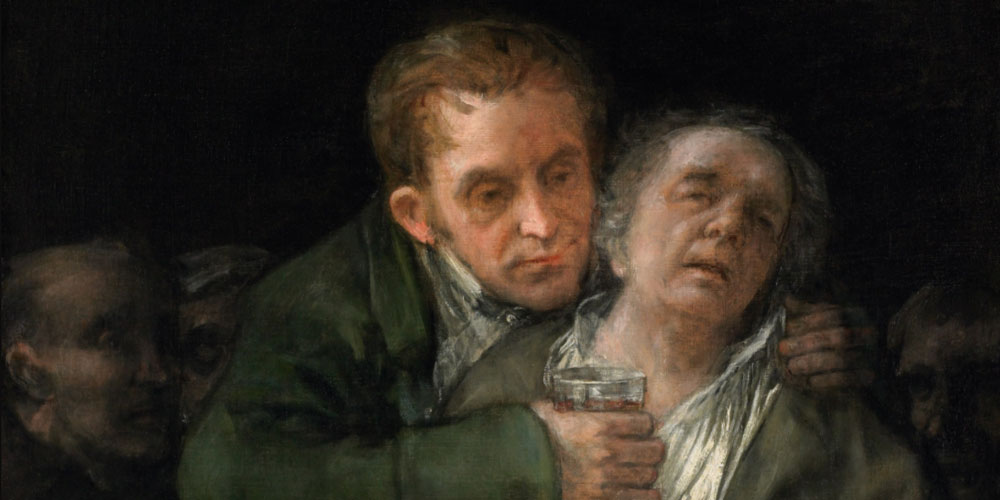On WNRI 1380 AM/95.1 FM, John DePetro and Justin Katz discuss:
- State budget details tell a story
- The many forms of leave for a state worker
- Lynch endorses Amo
- The radicalism of Regunberg
- The reactionaries hold on to the armory
Featured image by Norman Rockwell on WikiArt.
[Open full post]On WNRI 1380 AM/95.1 FM, John DePetro and Justin Katz discuss:
- Evil glee at making people pay for abortion
- Differential treatment of two misbehaving local officials
- The RIPTA job mill
- Progressives’ privilege in public schools
- No sympathy for the early retirees
Featured image by Edwin Lord Mills on WikiArt.
[Open full post]Let’s go through all of the basics. Most basic of all: A debt remains real, even when you don’t have the money to pay it.
And what makes a debt real? Basically, a debt is real when the parties who agreed to it and other parties around them agree that something bad will happen, if it is not paid.
Everyone already understands that the United States of America missing a national debt payment leads to something bad. Ergo, no one is questioning the validity of the National Debt of the United States, and there is no action that the President of the United States or any other branch of government needs to take or can take to further establish its validity.
The United States Constitution authorizes several ways for Congress to raise money to pay a valid debt. The primary ones are laying and collecting taxes and borrowing money on the credit of the United States.
The President has no more power to pay a valid debt by borrowing money without Congressional authorization than he does to pay a valid debt by raising taxes without Congressional authorization.
Any attempt by the President to borrow money without Congressional authorization would constitute an unlawful suspension of the United States Constitution, and would be every bit as egregious as the President decreeing that he had suspended the Constitution so that he could impose taxes without Congressional approval.
We live in strange times when the progressive left wants the President of the United States to unilaterally terminate the American government’s Constitutional revenue and appropriations process, in order to guarantee that big financiers never face risk.
Featured image from Shutterstock.
[Open full post]The most essential insight of George Orwell’s 1984 is that it isn’t enough for totalitarians to dominate. They must demand subjugated people acknowledge them as the arbiters of reality itself. This quality is the telltale warning about a movement’s nature, and spotting its bizarre appearance in the United States, I’m beginning to wonder whether our constitutional safeguards against totalitarianism forced it to take a contorted shape.
That shape is clearly visible in the what-reality-are-we-in controversy over the L.A. Dodgers’ disinvitation of “The Sisters of Perpetual Indulgence” from the baseball team’s “Pride Night” event. What the group is about is entirely obvious, but our society is in such a near-totalitarian state of confusion a veil of mainstream narrative is draped across the radical face of reality. With that veil in place, the Dodgers failed to anticipate that the invitation — and giving the group a “Community Hero Award” — would generate a negative response.
Manipulators like CBS News provide no images of the “sisters” and leave a giant question mark about why anybody would be offended by the group. One must turn to the New York Post for details like this:
The “nuns” — who have names like Sister T’aint A Virgin, Sister Porn Again and Sister Holly Lewya — were being awarded for supposedly “promoting human rights and respect for diversity and spiritual enlightenment.”
The “sisters” (mostly men dressed up in a mocking imitation of women) claims to be a charitable organization, but what is their charity?
We use humor and irreverent wit to expose the forces of bigotry, complacency and guilt that chain the human spirit.
And whom do they attack with their “irreverent wit”? Christians, naturally, more specifically Catholics, and more specifically nuns. Their “charity” is to offend people with whose beliefs they disagree. They choose the most holy days to mock Christians, and their costumes are obviously malicious. Mockery and hatred are their reasons for being — their identity. This is unambiguous, and to accept such activity as charitable is to adopt their bigotry.
The context was different decades ago, when the culture had a Christian consensus. Irreverence became a mainstay of comedy and counterculture as a way to take a breather from reality and gain some distance by which to test assumptions. When the counterculture becomes the driving force of the mainstream, however, the mockery takes on a wholly different character.
In an essay for National Review, the father of a teacher and student who survived the Covenant School shooting makes a telling observation. Waiting for two hours to be reunited with his family after the attack, Graham Hillard watched the therapeutic state swoop in:
During that mind-focusing span, I acquired a series of insights that had previously been merely secondhand or theoretical. I learned that the ideology of psychotherapy has become so culturally ingrained that assembled parents were urged to “process” the day’s events even as those events remained ongoing. (In an irony worthy of Voltaire, the city-employed counselors stalking the aisles wore rainbow-flag lanyards.)
The tried-and-true test of the inverted counterfactual is instructive. What if a murderous Christian zealot targeted an institution focused on gay families and the government therapists showed up wearing crosses?
To be sure, the city workers could not have known the shooter’s motives at the time (which motives, Hillard notes, authorities appear to be minimizing even now by withholding her “manifesto”), but we cannot be confident it would have mattered. After all, they knew they were going to a Christian school and apparently didn’t reconsider their ideologically charged lanyards.
A culture in which maliciously mocking Catholic nuns is a form of charity begets a society in which Christians should be grateful for whatever comforts government is still compelled to offer them and a school shooting is a fine time for sartorial evangelism. The totalitarians will grin as they insist it’s a matter of civil rights to force people to pay the bill when others wish to kill their own children, and the inexorable logic of evil will demand ever-more-visible declarations that two plus two equals five.
Featured image from Shutterstock.
[Open full post]In recent conversation with Tim Ferriss, Canadian writer-explorer Wade Davis took a slight detour to speak of the community benefits of Canada’s socialized healthcare system:
It has everything to do with social solidarity. It has everything to do with every Canadian knowing that they belong, and knowing that if their kid gets sick, they will get exactly, and I tell you, it is exactly, the same care as any other Canadian, including the Prime Minister. Yes, I sometimes have to wait for medical service in Canada, but everyone does, but no one is left behind. And that is one of the reasons that we have a less highly charged society, why we seem to get along better.
At the same time, Rod Dreher observes this of Canadian healthcare:
… the state and the medical profession are rapidly creating a culture in Canada in which people who cannot care for themselves will be pushed to commit suicide so as not to be a burden on others — in part because the healthy and the financially well off will have been conditioned to think that they have no obligation out of sheer human decency to help those who are suffering. Remember, the concept of “soft totalitarianism” that I talk about in Live Not By Lies is a totalitarianism that takes root because of a population’s unwillingness to suffer pain and anxiety. We see in Canada that the state and other institutions captured by progressive ideology are teaching Canadians to internalize an ideology that tells them that some lives are unworthy of life, and should be ended “beautifully” by the system.
For our purpose, here, let’s not focus on the practical reality of whether Davis’s testimony is correct and, instead, focus on the socialist belief, whether true or not. A shared government system, the thinking goes, provides “equitable” care to all. Sure, the privileged must sacrifice on behalf of this levelling, but they are rewarded with life in a friendlier, more-communal society.
Yet, people remain human and self-interested. If you feel that you’ve been tolerating a lower degree of service for the benefit of others, you may resent those who waste your shared resources to prolong, as Dreher puts it, a “life unworthy of life.”
Notably, Dreher takes that phrase from a Nazi principle, which dovetails with his characterization of euthanasia as evidence of “the re-paganization of a once-Christian civilization.” He points out that, in ancient Rome, early Christians would rescue unwanted babies whose parents had left them outside to die of exposure. Indeed, perhaps the most significant practical (as distinct from theological) attribute of Christianity, producing all that followed, was the idea that every person matters as a being in relationship with God.
These days, unwanted children are aborted, rather than left to die. While that may be more humane, in a sense, it also comes with the assumption that their lives are not worthy of life because their parents do not wish to care for them. The poor, disabled, and merely unhappy are now receiving the message that the caretaker collective has reached the same conclusion.
When government is tasked with maintaining social solidarity and possesses the means to kill nicely, citizens may feel as if their community is more tightly knit, but with a sharper edge. Move beyond that people aren’t “left behind,” but their encouraged to suppress the highly charged desire for life and drop out of life with a smile.
Featured image by Francisco Goya on WikiArt.
[Open full post]On WNRI 1380 AM/95.1 FM, John DePetro and Justin Katz discuss:
- McKee adopts all of RI’s homeless (on the way to socialized housing)
- Barrington teachers get COVID-excess accountability (well, it’s a start)
- How and why the media ignores the most important story in RI education
- Pandering to radicals for a non-existent gun problem in Rhode Island
- Voter fraud and the story the RIGOP needs to tell
Featured image from Shutterstock.
[Open full post]Stephen Skoly considers a run for CD1, Neil deMause talks publicly backed stadiums, Joseph Allen on AI, Mike Davis talks about Senator Whitehouse and the Supreme Court, and Mike Stenhouse of the RI Center for Freedom and Prosperity.
Featured image from Shutterstock.
[Open full post]Announcing the move of his cable news show to Twitter, Tucker Carlson suggests that most of what mainstream journalists report is factually true, but their stories are chosen and constructed so as to paint a completely false image of reality. Take Rhode Island education as an example.
As long as I’ve been following the story, government-run education in Rhode Island has been expensive and ineffective relative to other states (let alone to private options and the world). Just a few years ago, a team from Johns Hopkins University conducted a review of education in Providence, and the Wall Street Journal characterized its findings as “An Education Horror Show.” As a result, the state took over the schools, but without any signs of improvement. Why?
Because the teacher unions dug in, and Education Commissioner Angelica Infante-Green (then newly appointed) attempted to work with them. Whether you agree with me that her decision (urged by the politically ambitious Democrat governor, Gina Raimondo, no doubt) was a cataclysmic mistake or see it as a necessity, even if challenging, you simply must acknowledge that the unions are central to the story of Rhode Island education.
And yet, a single four-month-old story in GoLocalProv is the only instance I can find covering John Lancellotta’s lawsuit against the West Warwick school department alleging that he was let go because he exercised his constitutionally guaranteed right not to pay dues to a teacher union. Why?
Because for a variety of reasons journalists don’t want to help spread the information that teachers don’t have to join their local unions. A few of them came of age at a time when unions were considered heroic, and they can’t shake that narrative, so Lancellotta falls immediately into the character of suspicious troublemaker. The younger journalists have recently emerged from a K-BA system that is more about indoctrination than education. Others are fully onboard with the progressive movement of which government unions are a driving organizational force. Some are probably (consciously or otherwise) wary of landing on the disfavored list of the most powerful people in the Ocean State.
As a purely economic decision, remaining in a teacher union makes no sense for any individual teacher, yet it’s extremely rare for teachers not to opt in. This results from a multilayered campaign to prop up union membership. The broadest layer is of inculcated ignorance, whereby teachers simply don’t know their rights. Colleges of education certainly won’t explain their options to students, and journalists help to keep teachers from having reason to investigate for themselves.
As the layers become more focused, they involve deception about what being in or out of the union entails. Another layer lays deliberate obstacles to being non-union (e.g., the district office simply begins deducting dues, and the superintendent tells the teacher she has to discuss the matter with the district’s union leader, who imposes improper obstacles). The most pointed layer includes experiences such as Lancellotta’s, which send warning messages to any teachers who still come to the conclusion that avoiding the union is the right decision for them.
Whatever individuals’ conclusions might be, a fully informed citizenry would be familiar with this reality and understand its connection to school failure in Providence and elsewhere. Unfortunately, as Carlson explains, a well funded and influential industry is dedicated to ensuring that the public is not familiar with any reality but the one ideologues want to be true.
Featured image by Kristina Flour on Unsplash.
[Open full post]









